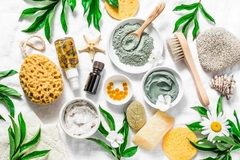Beauty packaging trends: Eco-friendly formats push “paperization,” exotic woods mimics and bio-composites
The beauty sector is seeing an uptick in trending packaging solutions inspired by the rise of “paperization,” elevated wood features, bio-composite luxury products and refillable formats. Personal Care Insights showcases the latest advancements from Constantia Flexibles, Sulapac and Quadpack.
“In the sustainable beauty packaging space, we are observing several trends shaping the industry. There is a clear shift towards flexible packaging, as it often requires fewer resources and offers greater efficiency, particularly for products like soaps and liquids,” says Peter Kerkhofs, market product manager HPC – Film & Paper Category at Constantia Flexibles.
“Refill concepts are gaining traction, with innovations like soap pouches to refill rigid containers or refill systems for glass jars using plastic cups with peelable lidding. The rise of ‘paperization,’ where packaging mimics the look and feel of paper, appeals to more eco-conscious consumers while enhancing brand storytelling in applications like sachets and wrappers.”
Aptar Beauty recently highlighted the innovative use of paper in its lightweight, “highly customizable” fragrance packaging solution, which includes an “extra-flat” spray for streamlined product sampling.
“Lightweight, flexible formats are gaining popularity for their ability to reduce material usage and therefore reducing CO2 emissions while maintaining performance,” continues Kerkhofs.
“Additionally, products incorporating recycled content — even if they deviate from traditional aesthetics like shiny or white finishes — are increasingly accepted and valued. Finally, advanced dispensing systems are improving functionality and usability while aligning with sustainability goals.”
 EcoLamPlus mono PE laminate by Constantia Flexibles (Image credit: Constantia Flexibles).Kerkhofs points out that consumers are increasingly willing to pay a premium for more sustainable packaging. “Markets with higher environmental awareness, such as Europe, are particularly viable, as consumers in these regions prioritize more eco-friendly solutions and appreciate the long-term benefits of recyclable materials,” he says.
EcoLamPlus mono PE laminate by Constantia Flexibles (Image credit: Constantia Flexibles).Kerkhofs points out that consumers are increasingly willing to pay a premium for more sustainable packaging. “Markets with higher environmental awareness, such as Europe, are particularly viable, as consumers in these regions prioritize more eco-friendly solutions and appreciate the long-term benefits of recyclable materials,” he says.
Constantia Flexibles
As with a growing segment of suppliers, Constantia Flexibles’ latest innovations in beauty packaging involve reducing environmental impact while maintaining functionality and performance.
The Austria-based company’s advancements include EcoPaperHighPlus, a paper-based solution ideal for sachets in skin and hair care, and EcoLamPlus, designed for refill pouches for soaps, skin care and sun care, offering durability with more eco-consciousness.
“For refill cup systems, EcoPeelCover offers an innovative peelable lidding solution, ideal for pairing with plastic cups in glass skincare packaging, ensuring material reduction while keeping convenience for the consumer,” Kerkhofs tells Personal Care Insights.
“We also have in our portfolio EcoLamHighPlus, a high-barrier PE laminate perfect for face masks and promotional sachets, and EcoLamPlus (mono PE laminate) or EcoVer (mono PP laminate) solutions optimized for wipes packaging. Additionally, EcoVerHighPlus, a high-barrier mono PP laminate, and EcoPaper, crafted for soap wrappers, provide robust and sustainable alternatives for diverse beauty packaging needs.”
Sulapac
The luxury perfume house Byredo recently collaborated with FaiveleyTech in the creation of the cap for its new fragrance: Mojave Ghost Absolu de Parfum. The piece, made with Sulapac biocomposite material, exemplifies the growing use of natural materials.
The FaiveleyTech Beauty Unit, in close collaboration with its partner Sulapac, took on the challenge set by Byredo’s creators. For its Mojave Ghost Absolu de Parfum, Byredo chose a cap that mimics the visual and textural effects of Japanese burnt wood, which the company says aligns with the “raw and authentic character of the fragrance composition.”
Byredo selected a biocomposite material formulated by Sulapac to reduce the use of fossil feedstock and lower its carbon footprint. The raw and aged wood texture was an exclusive creation specifically developed for this project. It combines intricate engraving with an injection molding process. The cap and its magnetic components are assembled on a fully automated line, enabling magnetic fit to the bottle.
“The teams brought forth an audacious and original project, evoking craftsmanship and nature, which we draw inspiration from. Our processes were pushed to their limits with great energy, and the result, in both the fragrance and the packaging, highlights the brand’s original signature,” says Beryl Tomaschett, sales director of FaiveleyTech Orgelet.
Sulapac and FaiveleyTech revealed several other sustainable beauty packaging pipeline launches this year that align with the growing bio-based packaging theme. The duo introduced a marble-like finish for cosmetic packaging made of bio-based Sulapac materials.
Sulapac has also previously collaborated on high-end bio-based refillable jars and deodorant sticks.
Quadpack
Quadpack addresses the trend of incorporating luxury wood in beauty packaging at a fraction of the cost. It crafts beauty packaging from common wood types like ash, which can be equipped with finishing technologies that mimic the look of exotic wood species like wenge. This helps avoid the complexities of supply shortages, costs and carbon footprint that are associated with rare wood types.
 Quadpack released a fragrance cap that is 100% wood, equipped with its Woodacity closure system that functions just like plastic (Image credit: Quadpack).More recently, it released a fragrance cap that is 100% wood, equipped with Quadpack’s Woodacity closure system that functions just like plastic, made using only maple or ash wood from sustainably-managed forests, each with its own unique grain pattern.
Quadpack released a fragrance cap that is 100% wood, equipped with its Woodacity closure system that functions just like plastic (Image credit: Quadpack).More recently, it released a fragrance cap that is 100% wood, equipped with Quadpack’s Woodacity closure system that functions just like plastic, made using only maple or ash wood from sustainably-managed forests, each with its own unique grain pattern.
“Aimed squarely at the luxury market, the two-piece cap and ring combo hides the internal rib pattern, for a sleek, minimalist look. To further minimize impact, water-based, biodegradable glue is used to seamlessly join the pieces,” says Quadpack.
Designed and manufactured at the Quadpack Wood factory in Spain, Woodacity Hidden can be decorated with a host of luxury finishes, without affecting its impact. Custom outer shapes can also be created to align with unique brand identities.
In addition, Quadpack offers wood that is certified by the Forest Stewardship Council (FSC), a mark of sustainable forestry. This certification verifies that the raw materials, from sources to distribution, are managed sustainably. At the end of its life, consumers can simply discard it without separating. It is available with a click or friction fit for various pump systems.
Quadpack created maple caps and collars, as well as fragrance roll-ons, for Sisley’s neuroscience-based skin care brand Neuraé. Neuraé’s formulas are composed of at least 95% ingredients of natural origin. The range comprises a serum and a choice of three face creams, complemented by roll-on fragrances it calls “Emotion Boosters.”
What’s next for beauty packaging
Kerkhofs at Constantia Flexibles tells Personal Care Insights that eco-friendly beauty packaging, recyclable plastics, particularly mono-material solutions like PE and PP, are leading the trend due to their compatibility with existing recycling systems.
“In the coming years, we expect to see a decline in the popularity of unsustainable materials and formats, particularly single-use packaging like sachets, as consumers increasingly perceive single-use and small portions as environmentally negative,” he says.
“The reliance on virgin materials is also likely to decrease, with a growing preference for packaging that incorporates recycled content. Packaging combining several materials — often excessive or seen as unnecessary — may also face reduced demand as sustainability takes precedence.”
“Additionally, there is a noticeable shift from rigid packaging formats toward refillable solutions, supported by trends in downgauging, where packaging uses less material while integrating recycled components, aligning with consumer expectations for more eco-conscious design.”














